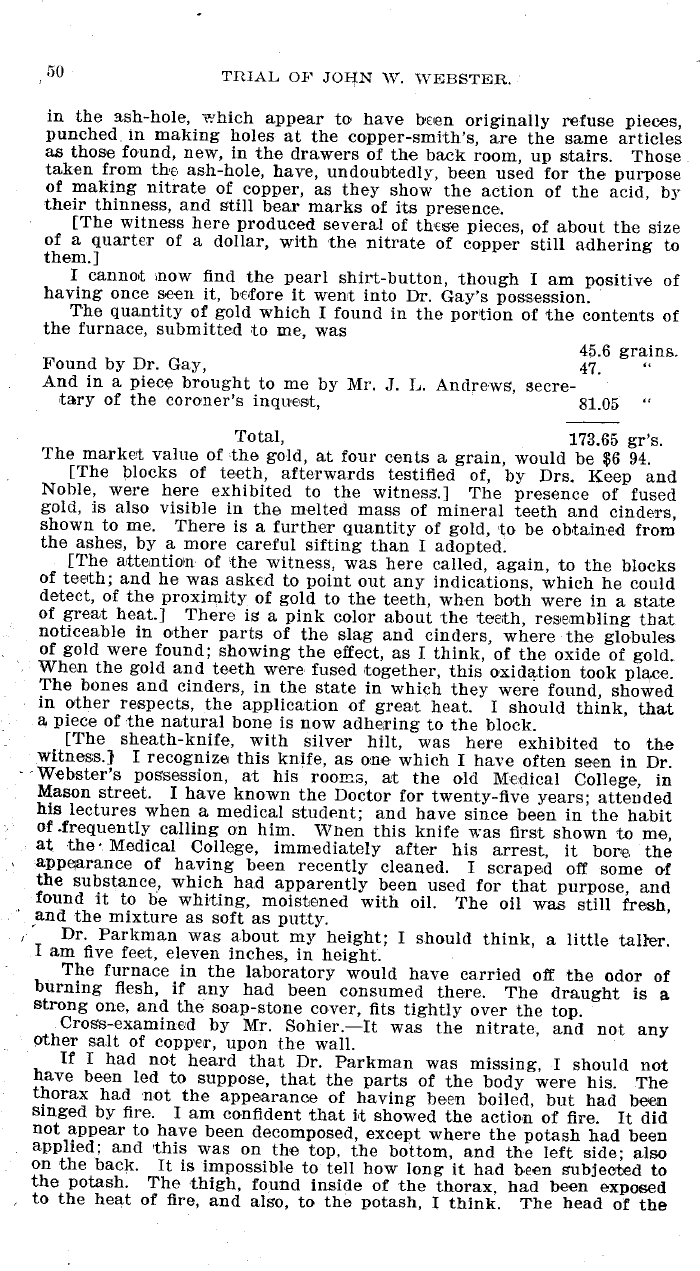|
50 TRIAL OF JOHN W. WEBSTER.
in the ash-hole, which appear to have b-eien originally refuse pieces,
punched in making holes at the copper-smith's, are the same articles
as those found, new, in the drawers of the back room, up stairs. Those
taken from the ash-hole, have, undoubtedly, been used for the purpose
of making nitrate of copper, as they show the action of the acid, by
their thinness, and still bear marks of its presence.
[The witness here produced several of these pieces, of about the size
of a quarter of a dollar, with the nitrate of copper still adhering to
them.]
I cannot tow find the pearl shirt-button, though I am positive of
having once seen it, before it went into Dr. Gay's possession.
The quantity of gold which I found in the portion of the contents of
the furnace, submitted to me, was
45.6 grains.
Found by Dr. Gay, 47,
And in a piece brought to me by Mr. J. L. Andrews, secre-
tary of the coroner's inquest, 81.05 "
Total, 173.65 gr's.
The market value of the gold, at four cents a grain, would be $6 94.
[The blocks of teeth, afterwards testified of, by Drs. Keep and
Noble, were here exhibited to the witness.] The presence of fused
gold, is also visible in the melted mass of mineral teeth and cinders,
shown to me. There is a further quantity of gold, to be obtained from
the ashes, by a more careful sifting than I adopted.
[The attention of the witness, was here called, again, to the blocks
of teeth; and he was asked to point out any indications, which he could
detect, of the proximity of gold to the teeth, when both were in a state
of great heat.] There is a pink color about the teeth, resembling that
noticeable in other parts of the slag and cinders, where the globules
of gold were found; showing the effect, as I think, of the oxide of gold.
When the gold and teeth were fused together, this oxidation took place.
The bones and cinders, in the state in which they were found, showed
in other respects, the application of great heat. I should think, that
a piece of the natural bone is now adhering to the block.
[The sheath-knife, with silver hilt, was here exhibited to the
witness.) I recognize this knife, as one which I have often seen in Dr.
Webster's possession, at his rooms, at the old Medical College, in
Mason street. I have known the Doctor for twenty-five years; attended
his lectures when a medical student; and have since been in the habit
of .frequently calling on him. When this knife was first shown to me,
at the , Medical College, immediately after his arrest, it bore, the
appearance of having been recently cleaned. I scraped off some of
the substance, which had apparently been used for that purpose, and
found it to be whiting, moistened with oil. The oil was still fresh,
and the mixture as soft as putty.
Dr. Parkman was about my height; I should think, a little taller.
I am five feet, eleven inches, in height.
The furnace in the laboratory would have carried off the odor of
burning flesh, if any had been consumed there. The draught is a
strong one, and the soap-stone cover, fits tightly over the top.
Cross-examined by Mr. Sohier.-It was the nitrate, and not any
other salt of copper, upon the wall.
If I had not heard that Dr. Parkman was missing, I should not
have been led to suppose, that the parts of the body were his. The
thorax had not the appearance of having been boiled, but had been
singed by fire. I am confident that It showed the action of fire. It did
not appear to have been decomposed, except where the potash had been
applied; and this was on the top, the bottom, and the left side; also
on the back. It is impossible to tell how long it had been subjected to
the potash. The thigh found inside of the thorax, had been exposed
to the heat of fire, and also, to the potash, I think. The head of the
|

